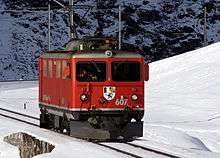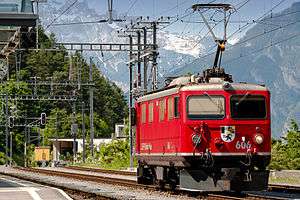Rhaetian Railway Ge 4/4 I
| Rhaetian Railway Ge 4/4 I | |||||||||||||||||||||
|---|---|---|---|---|---|---|---|---|---|---|---|---|---|---|---|---|---|---|---|---|---|
|
| |||||||||||||||||||||
| |||||||||||||||||||||
| |||||||||||||||||||||
| |||||||||||||||||||||
| |||||||||||||||||||||
The Rhaetian Railway Ge 4/4 I is a class of metre gauge Bo-Bo electric locomotives operated by the Rhaetian Railway (RhB), which is the main railway network in the Canton of Graubünden, Switzerland.
The class is so named because it was the first class of locomotives of the Swiss locomotive and railcar classification type Ge 4/4 to be acquired by the Rhaetian Railway. According to that type designation, Ge 4/4 denotes a narrow gauge electric adhesion locomotive with a total of four axles, all of which are drive axles.
The 10 machines in the Ge 4/4 I class were also the first RhB electric locomotives without rod drive.
History
In 1944, the Rhaetian Railway ordered four Ge 4/4 I class locomotives from the Swiss Locomotive and Machine Works (SLM). The first of these machines was commissioned in July 1947. In service primarily in the haulage of fast trains, they proved themselves so well that in 1953 the Rhaetian Railway ordered six further examples.
The later entry into service of the Ge 6/6 II and the Ge 4/4 II class locomotives led to the cascading of the Ge 4/4 I class into lesser responsibilities.
Between 1986 and 1991, the Ge 4/4 I class was completely modernised. For example, the old cab fronts with their communication doors were replaced with new cab fronts. Since their modernisation, the locomotives in the class have continued to render loyal service to the Rhaetian Railway right up to today.
Specifications

The Ge 4/4 I class locomotives presently have a top speed of 80 kilometres per hour (50 mph) (originally 75 kilometres per hour or 47 miles per hour) and a power output of 1,184 kilowatts (1,588 hp). They now weigh 48 tonnes (47 long tons; 53 short tons) (originally 47 tonnes or 46 long tons or 52 short tons) and are 12,100 millimetres (39 ft 8 in) long.
Beginning in 1997, the Ge 4/4 I class's old diamond-shaped pantographs were replaced by new single-arm pantographs, to enable deployment of the class on the Chur-Arosa line, which at that time was having its electrification system changed.
The names of the 10 locomotives in the class commemorate the names of certain valleys, mountains and mountain ranges in Graubünden. The names are located high on the left and right sides of the locomotives, in white script on a red background. The service numbers 601–610 are on both cab ends, and also on the lower sides.
Current operations
An important present day area of operation for the Ge 4/4 I class is the Rhaetian Railway line from Davos to Filisur, with its many tunnels. Since December 2004, the class has operated three car push-pull trains, consisting of a Steuerwagen BDt 172x, an Einheitswagen I B and an Einheitswagen III A, on this line. Previously, modernised centre entry cars were used on these services. Between Davos and Filisur, the introduction of the push pull trains has reduced the operating requirement to one consist of cars, instead of the two sets that were previously required.
In winter, the Ge 4/4 I class also hauls the Bergün-Preda-Bergün toboggan trains, and a few other wintersport trains in Prättigau.
Disposal and Preservation
During November 2010, the Rhaetian Railways began taking most of the locomotives of this series after more than 50 years of service, most were disposed off and scrapped, which included Ge 4/4I's 601/604/606/608/609, however four remain to this day, but however two are still in operation with Rhaetain Railways, 605 and 610,
While at a time of withdrawal commenced, two where saved in heritage collection, 602 named "Bernina" was passed in March 7, 2012 to the Museum of Transport, in Lucerne (five-year lone) and later returned to Landquart for service again, while 603 "Badus" is distant to be preserved and brought to the Museum Augsburg Railway Park in Germany and kept in safe hands but as of today 603 is still in service but eventually sometime in the near future 603 will be brought to Germany to Augsburg in the not too distant future,
List of locomotives
The following locomotives in the class have served on the Rhaetian Railway:
| List of the Ge 4/4 I locomotives of the Rhaetian Railway | |||
| Traffic number | Name | Commissioning | Status |
| 601 | Albula | 8 July 1947 | scrapped November 2010 |
| 602 | Bernina | 21 July 1947 | Preserved in the Transport Museum in Lucerne on a five-year loan, from March 2012, o November 16, 2015, since November 16, 2015 again at the RhB. In service, |
| 603 | Badus | 13 August 1947 | Scheduled for Preservation in Augsburg Railway Park Germany, as of RhB still in service, |
| 604 | Calanda | 23 August 1947 | scrapped March 2011 |
| 605 | Silvretta | 12 March 1953 | in service |
| 606 | Kesch | 15 June 1953 | scrapped April 2011 |
| 607 | Surselva | 24 April 1953 | scrapped March 2011 |
| 608 | Madrisa | 15 June 1953 | scrapped March 2011 |
| 609 | Linard | 13 May 1953 | scrapped May 2011 |
| 610 | Viamala | 3 July 1953 | in service |
See also
References
- Belloncle, Patrick (2005). Das grosse Buch der Rhätischen Bahn: 1889–2001 [The Big Book of the Rhaetian Railway: 1889–2001]. Kerzers: Edition Viafer. ISBN 3952249408. (in German)
- Finke, Wolfgang; Schweers, Hans (1998). Die Fahrzeuge der Rhätischen Bahn. Band 3 Lokomotiven, Triebwagen, Traktoren 1889–1998 [The Motive Power of the Rhaetian Railway Vol 3 Locomotives, Railcars, Tractors 1889–1998]. Aachen: Verlag Schweers + Wall. ISBN 3894941057. (in German)
- Schönborn, Hans-Bernhard (2009). Die Rhätische Bahn Geschichte und Gegenwart [The Rhaetian Railway History and Present]. München: GeraMond. ISBN 9783765471629. (in German)
This article is based upon a translation of the German language version as at January 2010.

